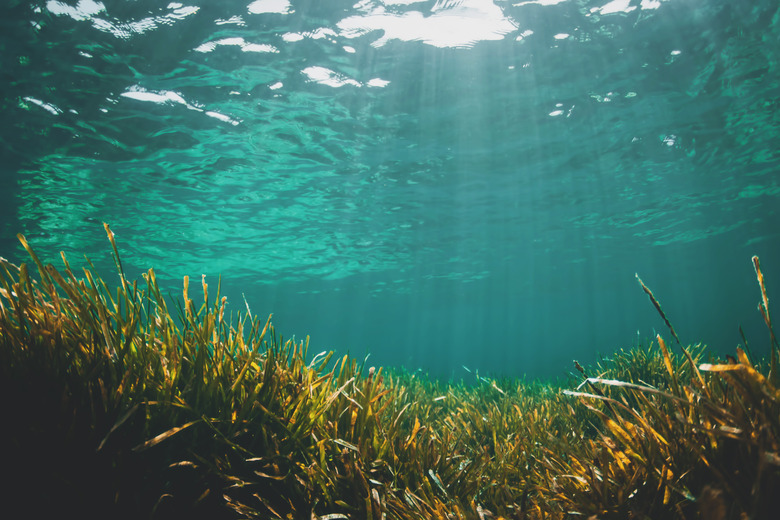What Plants Live In The Deep Ocean?
Plants are important primary producers on Earth. They are an essential source of food for animals, plus they alter the chemical composition of air and many water-based environments. Plants dominate the terrestrial landscape and also can live deep in the ocean.
Primary Producers
Primary Producers
Primary producers are the organisms capable of turning inorganic light or chemical energy into organic compounds used for growth. The majority of primary producers convert light energy through a process called photosynthesis. During photosynthesis, light energy from the sun, carbon dioxide and water are converted by cells into glucose for energy and oxygen as a byproduct. Plants, algae and some bacteria rely on photosynthesis for their energy supply.
Oceanic Zones
Oceanic Zones
The ocean is broadly divided into three zones depending on the light levels. The sunlight, or euphotic, zone spans from the water's surface to around 656 feet, where enough light for photosynthesis penetrates the water. The depths deep-sea plants can reach vary with the light levels in that region, so in tropical areas, plants are found further down where the visibility is higher and the euphotic zone is deeper.
There are still low levels of light entering the twilight, or dysphotic, zone which spans 656 to 3,280 feet, but typically there is not enough light for photosynthesis. The deepest zone is the midnight, or aphotic, zone below 3,280 feet where no light from the sun is present. Without the sun for photosynthesis plants cannot survive.
Deep Ocean Plants
Deep Ocean Plants
The primary flowering, vascular plant that lives in the ocean are seagrasses. There are around 72 different species of seagrasses around the world, and these are spread among four families. More is known about the seagrasses that prefer to live in shallow or brackish water less than 49 feet deep. Some species of these rare ocean plants have been collected at depths of 475 feet, though finding them below 164 feet is highly unusual.
Oceanic Algae
Oceanic Algae
In the ocean, algae are the dominant primary producers. Because of their need for light like plants, algae typically live as deep as the euphotic zone. They are often referred to as plants because they look comparable and play similar ecosystem roles in the ocean that plants do on land, but their taxonomy is diverse. There are many different species of algae, and there's much debate as to whether they all share a common evolutionary ancestor.
Like plants, green algae (phylum Chlorophyta) contain chlorophyll for photosynthesis. Unlike plants, this diverse group of over 7,000 species is primarily aquatic, living in either fresh or salt waters. Many species are unicellular and live as single cells in the ocean. Other species loosely group to form colonies. Larger, macroscopic algae, often referred to as seaweeds, are multicellular and look more like plants, like the common sea lettuce (Ulva spp.).
Red algae (phylum Rhodophyta) contain a pigment called phycoerythrin which reflects red light, giving them their red color, and they absorb blue light. Blue light can penetrate the water at greater depths than red light. This enables some red algae species to live in the upper levels of the dysphotic zone where other photosynthetic organisms wouldn't survive.
Deep Ocean Primary Producers
Deep Ocean Primary Producers
The primary producers of the deep oceanic zones are typically bacteria. Animals living in these harsh zones rely on eating bacteria to survive in the same way that animals rely on plants in the light-accessible zones of Earth. Because there is no light for photosynthesis, these bacteria must generate their energy through another method called chemosynthesis.
For chemosynthesis, bacteria oxidize hydrogen sulfide, a chemical that is toxic to most land-dwelling life. They get hydrogen sulfide from deep-sea hydrothermal vents that spew out an array of minerals and heavy metals at heats up to 752 degrees Fahrenheit.
References
- World Wildlife Fund: Oases on the Ocean Floor
- National Ocean Service: How Far Does Light Travel in the Ocean?
- Smithsonian Ocean: Seagrass and Seagrass Beds
- National Geographic: Photosynthesis
- University of California Museum of Paleontology: Rhodophyta
- Marine Pollution Bulletin: The Discovery of Deep-Water Seagrass Meadows in a Pristine Indian Ocean Wilderness Revealed by Tracking Green Turtles
- University of California Museum of Paleontology: Green Algae
- Marine Education Society for Australasia: Green Algae (Chlorophyta)
Cite This Article
MLA
Jerrett, Adrianne. "What Plants Live In The Deep Ocean?" sciencing.com, https://www.sciencing.com/what-plants-live-in-the-deep-ocean-12329069/. 30 September 2021.
APA
Jerrett, Adrianne. (2021, September 30). What Plants Live In The Deep Ocean?. sciencing.com. Retrieved from https://www.sciencing.com/what-plants-live-in-the-deep-ocean-12329069/
Chicago
Jerrett, Adrianne. What Plants Live In The Deep Ocean? last modified August 30, 2022. https://www.sciencing.com/what-plants-live-in-the-deep-ocean-12329069/
